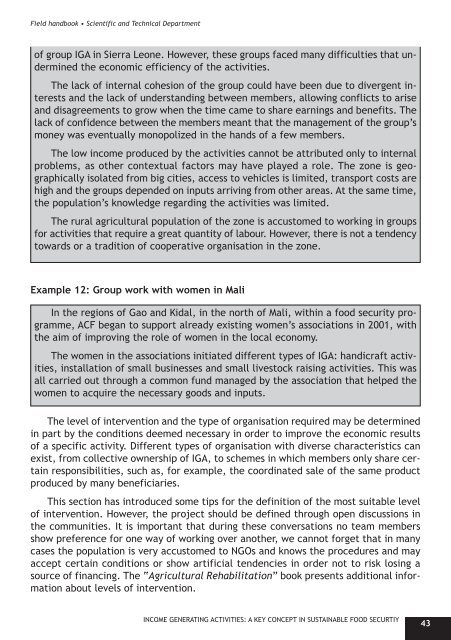Income-Generating Activities - Action Against Hunger
Income-Generating Activities - Action Against Hunger
Income-Generating Activities - Action Against Hunger
You also want an ePaper? Increase the reach of your titles
YUMPU automatically turns print PDFs into web optimized ePapers that Google loves.
Field handbook • Scientific and Technical Department<br />
of group IGA in Sierra Leone. However, these groups faced many difficulties that undermined<br />
the economic efficiency of the activities.<br />
The lack of internal cohesion of the group could have been due to divergent interests<br />
and the lack of understanding between members, allowing conflicts to arise<br />
and disagreements to grow when the time came to share earnings and benefits. The<br />
lack of confidence between the members meant that the management of the group’s<br />
money was eventually monopolized in the hands of a few members.<br />
The low income produced by the activities cannot be attributed only to internal<br />
problems, as other contextual factors may have played a role. The zone is geographically<br />
isolated from big cities, access to vehicles is limited, transport costs are<br />
high and the groups depended on inputs arriving from other areas. At the same time,<br />
the population’s knowledge regarding the activities was limited.<br />
The rural agricultural population of the zone is accustomed to working in groups<br />
for activities that require a great quantity of labour. However, there is not a tendency<br />
towards or a tradition of cooperative organisation in the zone.<br />
Example 12: Group work with women in Mali<br />
In the regions of Gao and Kidal, in the north of Mali, within a food security programme,<br />
ACF began to support already existing women’s associations in 2001, with<br />
the aim of improving the role of women in the local economy.<br />
The women in the associations initiated different types of IGA: handicraft activities,<br />
installation of small businesses and small livestock raising activities. This was<br />
all carried out through a common fund managed by the association that helped the<br />
women to acquire the necessary goods and inputs.<br />
The level of intervention and the type of organisation required may be determined<br />
in part by the conditions deemed necessary in order to improve the economic results<br />
of a specific activity. Different types of organisation with diverse characteristics can<br />
exist, from collective ownership of IGA, to schemes in which members only share certain<br />
responsibilities, such as, for example, the coordinated sale of the same product<br />
produced by many beneficiaries.<br />
This section has introduced some tips for the definition of the most suitable level<br />
of intervention. However, the project should be defined through open discussions in<br />
the communities. It is important that during these conversations no team members<br />
show preference for one way of working over another, we cannot forget that in many<br />
cases the population is very accustomed to NGOs and knows the procedures and may<br />
accept certain conditions or show artificial tendencies in order not to risk losing a<br />
source of financing. The “Agricultural Rehabilitation” book presents additional information<br />
about levels of intervention.<br />
INCOME GENERATING ACTIVITIES: A KEY CONCEPT IN SUSTAINABLE FOOD SECURTIY<br />
43

















